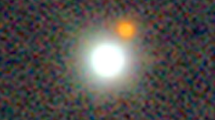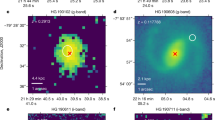Abstract
The number of baryons detected in the low-redshift (z < 1) Universe is far smaller than the number detected in corresponding volumes at higher redshifts. Simulations1,2,3 of the formation of structure in the Universe show that up to two-thirds of the ‘missing’ baryons may have escaped detection because of their high temperature and low density. One of the few ways to detect this matter directly is to look for its signature in the form of ultraviolet absorption lines in the spectra of background sources such as quasars. Here we show that the amplitude of the average velocity vector of ‘high velocity’ O vi (O5+) absorption clouds detected in a survey4 of ultraviolet emission from active galactic nuclei decreases significantly when the vector is transformed to the frames of the Galactic Standard of Rest and the Local Group of galaxies. At least 82 per cent of these absorbers are not associated with any ‘high velocity’ atomic hydrogen complex in our Galaxy, and are therefore likely to result from a primordial warm–hot intergalactic medium pervading an extended corona around the Milky Way or the Local Group. The total mass of baryons in this medium is estimated to be up to ∼1012 solar masses, which is of the order of the mass required5 to dynamically stabilize the Local Group.
This is a preview of subscription content, access via your institution
Access options
Subscribe to this journal
Receive 51 print issues and online access
$199.00 per year
only $3.90 per issue
Buy this article
- Purchase on Springer Link
- Instant access to full article PDF
Prices may be subject to local taxes which are calculated during checkout


Similar content being viewed by others
References
Cen, R. & Ostriker, J. P. Where are the baryons? Astrophys. J. 514, 1–6 (1999)
Hellsten, U., Gnedin, N. Y. & Miralda-Escude', J. The X-ray forest: A new prediction of hierarchical structure formation models. Astrophys. J. 509, 56–61 (1998)
Davé, R. et al. Baryons in the warm-hot intergalactic medium. Astrophys. J. 552, 473–483 (2001)
Sembach, K. R. et al. Highly-ionized high-velocity gas in the vicinity of the galaxy. Astrophys. J. Suppl. (2002) (submitted); preprint astro-ph/0207562 at 〈http://xxx.lanl.gov〉 (2002)
Kahn, F. D. & Woltjer, L. Intergalactic matter and the galaxy. Astrophys. J. 130, 705–717 (1959)
Nicastro, F. et al. Chandra discovery of a tree in the X-ray forest towards PKS 2155-304: The local filament? Astrophys. J. 573, 157–167 (2002)
Canizares, C. R., Schattenburg, M. L. & Smith, H. I. The high energy transmission grating spectrometer for AXAF. Proc. SPIE 597, 253–260 (1986)
Moos, H. W. et al. Overview of the Far Ultraviolet Spectroscopic Explorer mission. Astrophys. J. 538, L1–L6 (2000)
Savage, B. D. et al. Far Ultraviolet Spectroscopic Explorer observations of O vi absorption in the galactic halo. Astrophys. J. 538, L27–L30 (2000)
Wakker, B. P. et al. The FUSE survey of galactic OVI. Am. Astron. Soc. 199, 6508 (2001)
Savage, et al. Distribution and kinematics of OVI in the Milky Way halo. Am. Astron. Soc. 199, 6504 (2001)
Howk, J. C., Savage, B. D., Sembach, K. R. & Hoopes, C. G. Far-Ultraviolet Spectroscopic Explorer observations of degree-scale variations in galactic halo OVI. Am. Astron. Soc. 572, 264–275 (2002)
Hoopes, C. G., Sembach, K. R., Howk, J. C., Savage, B. D. & Fullerton, A. W. A Far Ultraviolet Spectroscopic Explorer survey of interstellar O vi absorption in the Small Magellanic Cloud. Astrophys. J. 569, 233–244 (2002)
Sembach, K. R. et al. Far Ultraviolet Spectroscopic Explorer observations of O vi in high-velocity clouds. Astrophys. J. 538, L31–L34 (2000)
Sembach, K. R. High velocity clouds: Cosmological and galactic weather. Am. Astron. Soc. 199, 11301 (2001)
Heckman, T. M., Norman, C. A., Strickland, D. K. & Sembach, K. R. On the physical origin of OVI absorption-line systems. Astrophys. J. (in the press); preprint astro-ph/020556 at 〈http://xxx.lanl.gov〉 (2002)
Stark, A. A. et al. The Bell Laboratories H I survey. Astrophys. J. Suppl. Ser. 79, 77–104 (1992)
Wakker, B. P. Distances and metallicities of high- and intermediate-velocity clouds. Astrophys. J. Suppl. Ser. 136, 463–535 (2001)
Oort, J. H. Asymmetry in the distribution of stellar velocities. Observatory 49, 302–304 (1926)
Kravtsov, A. V., Klypin, A. & Hoffman, Y. Constrained simulations of the real universe: II. Observational signatures of intergalactic gas in the local supercluster region. Astrophys. J. (in the press); preprint astro-ph/0109077 at 〈http://xxx.lanl.gov〉 (2001)
Klypin, A., Hoffman, Y., Kravtsov, A. & Gottloeber, S. Constrained simulations of the real universe: The local supercluster. Astrophys. J. (2001) (submitted); preprint astro-ph/0107104 at 〈http://xxx.lanl.gov〉 (2001)
Grevesse, N. & Anders, E. Cosmic Abundances of Matter (ed. Waddington, C. J.) 1–8 (AIP Conference Proceedings Vol. 183, American Institute of Physics, New York, 1989)
Blitz, L., Spergel, D. N., Teuben, P. J., Hartmann, D. & Burton, W. B. High-velocity clouds: Building blocks of the local group. Astrophys. J. 514, 818–843 (1999)
Braun, R. & Burton, W. B. The kinematic and spatial deployment of compact, isolated high-velocity clouds. Astrophys. J. 341, 437–450 (1999)
Braun, R. & Burton, W. B. Status of HI searches for CHVCs beyond the local group. Astron. Astrophys. 375, 219–226 (2001)
de Heij, V., Braun, R. & Burton, W. B. An all-sky study of compact isolated high velocity clouds. Astron. Astrophys. (in the press); preprint astro-ph/0206306 at 〈http://xxx.lanl.gov〉 (2002)
Sternberg, A., McKee, C. F. & Wolfire, M. G. Atomic hydrogen gas in dark-matter minihalos and the compact high velocity clouds. Astrophys. J. Suppl. (2002) (in the press); preprint astro-ph/0207040 at 〈http://xxx.lanl.gov〉 (2002)
Sankrit, R., Kruk, J. W., Ake, T. B. & Anderson B.-G. The Fuse Data Analysis Cookbook v. 1.0 〈http://fuse.pha.jhu.edu/analysis/cookbook.html〉 (2001).
Freeman, P., Doe, S. & Siemiginowska, A. Sherpa: A mission-independent data analysis application. Proc. SPIE 4477, 76–87 (2001)
Draine, B. T. & Bertoldi, F. Structure of stationary photodissociation fronts. Astrophys. J. 468, 269–289 (1996)
Cecchi-Pestellini, C., Casu, S. & Dalgarno, A. The population of the high H2 rotational states towards the OMC-1 peak 1. Astrophys. J. (submitted)
Acknowledgements
F.N. thanks P. Kaaret and G. C. Perola for discussions and comments. We thank W.B. Burton for comments that helped improve the Letter. This work was partly supported by NASA-Chandra grants and a NASA-Chandra X-ray Center contract.
Author information
Authors and Affiliations
Corresponding author
Ethics declarations
Competing interests
The authors declare that they have no competing financial interests.
Rights and permissions
About this article
Cite this article
Nicastro, F., Zezas, A., Elvis, M. et al. The far-ultraviolet signature of the ‘missing’ baryons in the Local Group of galaxies. Nature 421, 719–721 (2003). https://doi.org/10.1038/nature01369
Received:
Accepted:
Issue Date:
DOI: https://doi.org/10.1038/nature01369
This article is cited by
-
Probing the mass and anisotropy of the Milky Way gaseous halo: sight-lines toward Mrk 421 and PKS 2155-304
Astrophysics and Space Science (2014)
-
18 years of science with the Hubble Space Telescope
Nature (2009)
-
FUV and X-Ray Absorption in the Warm-Hot Intergalactic Medium
Space Science Reviews (2008)
-
On the nature of the z=0 X-ray absorbers: I. Clues from an external group
Astrophysics and Space Science (2008)
-
The mass of the missing baryons in the X-ray forest of the warm–hot intergalactic medium
Nature (2005)
Comments
By submitting a comment you agree to abide by our Terms and Community Guidelines. If you find something abusive or that does not comply with our terms or guidelines please flag it as inappropriate.



